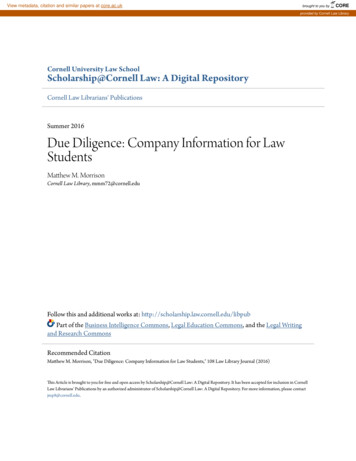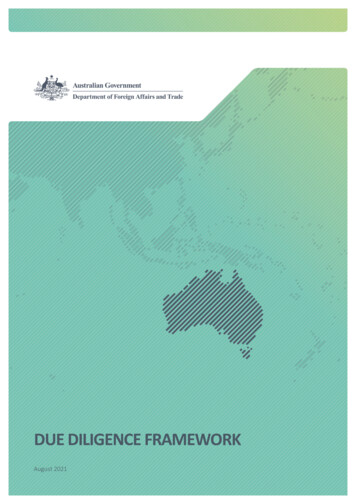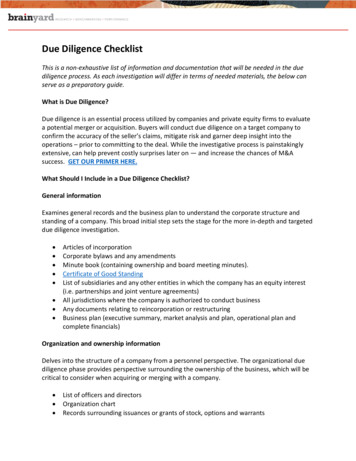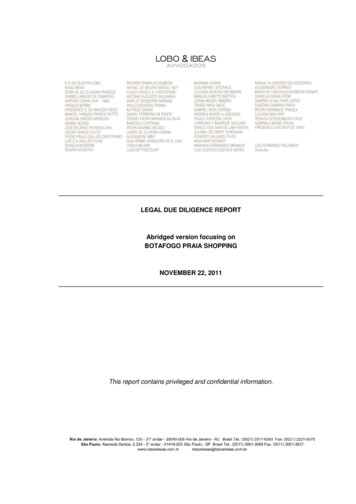
Transcription
View metadata, citation and similar papers at core.ac.ukbrought to you byCOREprovided by Cornell Law LibraryCornell University Law SchoolScholarship@Cornell Law: A Digital RepositoryCornell Law Librarians' PublicationsSummer 2016Due Diligence: Company Information for LawStudentsMatthew M. MorrisonCornell Law Library, mmm72@cornell.eduFollow this and additional works at: http://scholarship.law.cornell.edu/libpubPart of the Business Intelligence Commons, Legal Education Commons, and the Legal Writingand Research CommonsRecommended CitationMatthew M. Morrison, "Due Diligence: Company Information for Law Students," 108 Law Library Journal (2016)This Article is brought to you for free and open access by Scholarship@Cornell Law: A Digital Repository. It has been accepted for inclusion in CornellLaw Librarians' Publications by an authorized administrator of Scholarship@Cornell Law: A Digital Repository. For more information, please contactjmp8@cornell.edu.
LAW LIBRARY JOURNAL Vol. 108:3 [2016-21]Due Diligence: Company Information for Law Students*Matthew M. Morrison**Many law students are placed with corporate law firms whose clients are overwhelmingly companies. While many law school courses focus on doctrine, students need tolearn company information and where to find it. This article explains why teachingcompany information is crucial, where to find sources, and how to use these sources.Why Company Information?. . . . . . . . . . . . . . . . . . . . . . . . . . . . . . . . . . . . . . . . . . 427Employment Matters . . . . . . . . . . . . . . . . . . . . . . . . . . . . . . . . . . . . . . . . . . . . . . . . 428Current Corporate Clients. . . . . . . . . . . . . . . . . . . . . . . . . . . . . . . . . . . . . . . . . . 429Business Development. . . . . . . . . . . . . . . . . . . . . . . . . . . . . . . . . . . . . . . . . . . . . 429Mergers and Acquisitions Transactions. . . . . . . . . . . . . . . . . . . . . . . . . . . . . . . 430Finding and Understanding Company Information. . . . . . . . . . . . . . . . . . . . . . . 431What Third Parties Say About the Company and Its Industry. . . . . . . . . . . . . . . 431Directories. . . . . . . . . . . . . . . . . . . . . . . . . . . . . . . . . . . . . . . . . . . . . . . . . . . . . . . 431News . . . . . . . . . . . . . . . . . . . . . . . . . . . . . . . . . . . . . . . . . . . . . . . . . . . . . . . . . . . . . . 432Analysis . . . . . . . . . . . . . . . . . . . . . . . . . . . . . . . . . . . . . . . . . . . . . . . . . . . . . . . . . 433Industry Information. . . . . . . . . . . . . . . . . . . . . . . . . . . . . . . . . . . . . . . . . . . . . . 434Capital IQ . . . . . . . . . . . . . . . . . . . . . . . . . . . . . . . . . . . . . . . . . . . . . . . . . . . . . . . 435What the Company Says About Itself. . . . . . . . . . . . . . . . . . . . . . . . . . . . . . . . . . . 436Basic Legal Structure: Disclosure . . . . . . . . . . . . . . . . . . . . . . . . . . . . . . . . . . . . 436Annual Reports. . . . . . . . . . . . . . . . . . . . . . . . . . . . . . . . . . . . . . . . . . . . . . . . . . . 437Press Releases . . . . . . . . . . . . . . . . . . . . . . . . . . . . . . . . . . . . . . . . . . . . . . . . . . . . 438Investor/Earnings Conference Calls. . . . . . . . . . . . . . . . . . . . . . . . . . . . . . . . . . 439SEC Filings . . . . . . . . . . . . . . . . . . . . . . . . . . . . . . . . . . . . . . . . . . . . . . . . . . . . . . 440State Filings. . . . . . . . . . . . . . . . . . . . . . . . . . . . . . . . . . . . . . . . . . . . . . . . . . . . . . 444Insider Information and Stock Prices. . . . . . . . . . . . . . . . . . . . . . . . . . . . . . . . . . . 445Disclosure . . . . . . . . . . . . . . . . . . . . . . . . . . . . . . . . . . . . . . . . . . . . . . . . . . . . . . . 445Manipulative and Deceptive Trading Activity. . . . . . . . . . . . . . . . . . . . . . . . . . 446Conclusion . . . . . . . . . . . . . . . . . . . . . . . . . . . . . . . . . . . . . . . . . . . . . . . . . . . . . . . . . . . 448Why Company Information?¶1 Law students are not business students. Nonetheless, businesses are, sooften, a significant portion of a law student’s future employer’s clientele. Many* Matthew M. Morrison, 2016.** Faculty Services Librarian and Lecturer in Law, Cornell University Law Library, Ithaca, NewYork.427
428LAW LIBRARY JOURNALVol. 108:3 [2016-21]firms, especially larger ones, are known as “corporate law firms” for a reason.Indeed, many law students take courses on corporations, business law, transactional law, or all of these. At schools such as Cornell, these courses are subscribedin large numbers. However, these courses focus on doctrine. For students to bestserve their business clients, they need to understand the client itself: what does thecompany do; what is its competitive context; what basic law informs its activities;and what information does the client create, especially the information used tosatisfy legal requirements?¶2 A recent LexisNexis white paper underscores the importance of teachingbusiness information1 to law students. Three hundred hiring partners were surveyed, and ninety-five percent of those with transactional practices find newgraduates lacking in relevant skills.2 Skills identified as important include conducting due diligence research, finding basic company information, locating and usingchecklists, finding and reading Securities and Exchange Commission (SEC) filings,and staying current with business news.3 These are areas that I focus on whenteaching a business information course. In what follows, I expound on the why andhow of business information and the legal context in which it resides.Employment Matters¶3 According to the National Association for Law Placement, over half of theclass of 2013 went into private practice, with twenty percent of these working forlarge corporate firms.4 Others go on to work with business clients directly.5Whether in-house or outside counsel, new attorneys need to be versed in basiccompany information and its intersection with the law.¶4 Thus, students need to know the sources of company information and howand where to obtain it. Enter the law library to teach the main sources and researchmethods. In my advanced research course in business information, my courseobjectives are for the students to gain awareness and proficiency in the massive andcomplex range of business information sources while learning to assess the qualityand relevance of sources in a broad context. As a result of the employment reality,students must be prepared to handle the following three areas: current corporateclients, business development, and mergers and acquisitions transactions.1. I use “company information” and “business information” interchangeably, although “business information” is broader and may include transactional materials such as sample contracts.2. LexisNexis, White Paper: Hiring Partners Reveal New Attorney Readiness for RealWorld Practice (2015), 4926 large.pdf[https://perma.cc/4R7P-E2VE].3. Id. at 5–6.4. Nat’l Ass’n for Law Placement, Employment for the Class of 2013—Selected Findings,For Second Year in a Row New Grads Find More Jobs, Starting Salaries Rise—But OverallUnemployment Rate Rises with Historically Large Graduating Class 2–3 (2014), dings.pdf [https://perma.cc/7A3E-FYQD].5. Id. at 4. Business employment was at eighteen percent, a historic high. Id.
Vol. 108:3 [2016-21]DUE DILIGENCE: COMPANY INFORMATION FOR LAW STUDENTSCurrent Corporate Clients¶5 To provide the best advice to a current client, associates must have knowledge of that client’s business and industry, including key company personnel. In itsfirst-year associate training program, corporate law firm Drinker Biddle echoesthis.6 Moreover, according to Steve Lastres, Director of Knowledge ManagementServices for Debevoise and Plimpton, law students need to understand legal problems within a client’s larger business context, including specifics of companyinformation.7¶6 When working with current corporate clients, an attorney must also beaware of insider activity.8 They must know both the law and how to find the relevant documents. Relevant reports of insider transactions include Forms 3, 4, and5.9 To properly defend against an action under section 16(b) of the SecuritiesExchange Act,10 a company’s attorney must be well versed in the investigation ofthese reports.11Business Development¶7 Sizing up the competition and recruiting new clients is key in today’s competitive environment. Business development relies specifically on competitiveintelligence,12 which includes client intelligence.13 Competitive intelligence focuseson competitors;14 however, it must also include “major clients and prospects andtheir industries.”15 To be strategic, firms must track the industry trends of potentialclients.16 Moreover, identifying prospective clients relies not only on industryknowledge, but also knowing about key personnel working for the potential client.17 Client intelligence also directly informs the pitch to a new client. Attorneys6. The firm emphasizes that attorneys must “understand their clients’ business and industry.”Rachel J. Littman, Training Lawyers for the Real World Part Two, N.Y. St. B.J., Oct. 2010, at 33.7. Steven A. Lastres, Finding Common Ground: Linking Law School Student Learning to LawFirm Research Needs, Presentation to Cornell Law School Library, Mar. 9, 2015 (notes on file withauthor).8. Insiders include company officers, directors, and beneficial owners of more than ten percentof company securities. Fast Answers: Forms 3, 4, 5, U.S. Sec. & Exch. Comm’n, http://www.sec.gov/answers/form345.htm (last modified Jan. 15, 2013) [https://perma.cc/L7EF-GKBV].9. See 1 Arnold S. Jacobs, Section 16 of the Securities Exchange Act § 2:1, Westlaw (databaseupdated Mar. 2016).10. Section 16(b) of the Securities Exchange Act is codified at Securities Exchange Act of 1934,15 U.S.C. § 78p(b) (2012). Subsection (b) covers profits from the purchase and sale of securities byinsiders within six months and authorizes suit to recover ill-gotten gains.11. See 1 Jacobs, supra note 9, § 2:1.12. Competitive intelligence has multiple definitions but generally is focused on gathering andanalyzing information to better understand the competitive marketplace. See Ann Lee Gibson, How toCreate and Use Competitive Intelligence: 45 Tips for Law Firms, Law Prac., Mar. 2008, at 47–51.13. Client intelligence is a component of competitive intelligence. See From Client Intelligenceto Competitive Intelligence: Newest Addition to Hubbard One Monitor Suite Analyzes Millions of CourtDocuments, Law. PC, Dec. 15, 2011, at 6.14. Today, competitors may include clients themselves. See Jacob Gershman, Law Firms Face NewCompetition—Their Own Clients, Wall St. J. Blog (Sept. 15, 2014, 10:39 AM), -new-competition-their-own-clients/.15. Gibson, supra note 12, at 48.16. Id.17. Id. at 50.429
430LAW LIBRARY JOURNALVol. 108:3 [2016-21]should be thinking about how to prepare for the pitch and what solutions andstrategies should be proposed.18 This preparation is greatly informed by both company and industry information.Mergers and Acquisitions Transactions¶8 Mergers and acquisitions (M&A) are a major piece of a corporate law firm’swork. When acquisitions are in negotiation, due diligence is crucial while also timeconsuming and expensive; thus it is typically performed by young associates.19¶9 M&A due diligence involves several steps; the two most relevant ones arediscussed here. The first is getting to know the company, which includes its industry, as well as trade publications and prospectuses.20 The second step involves compiling information that is disseminated in disclosure documents, including proxiesand registration statements.21¶10 When one looks at M&A more closely, one can see the importance of teaching business information. M&A transactions require investigations—the acquiringcompany investigates the target,22 and the target investigates the acquiring company.¶11 The acquiring company has three objectives in its investigation of the target. First, does the target meet predetermined acquisition criteria?23 Second, theacquiring company wants to uncover any potential deal breakers, such as undisclosed liabilities, internal accounting defects, and unobtainable but necessary consents.24 Third, the acquirer wants information to evaluate the transaction.25¶12 The target company should do an investigation, too. First, the board ofdirectors must have sufficient information to confidently recommend the merger.26Second, the target company, in a stock-for-stock sale, will want to know the fullbackground of the acquirer.27 Finally, in a cash transaction, the target must knowwhether the acquiring company has sufficient funds.28¶13 The nature of these investigations reveals the importance of the range ofdocumentation that provides company information. Whether seller or buyer, thedetails revealed in disclosure and other documents are critical. Moreover, that mostof this due diligence work is done by young associates emphasizes the importanceand utility of offering a business information course to law students.18.19.20.21.22.Id.Stephen M. Bainbridge, Mergers and Acquisitions 83–84 (3d ed. 2012).Id. at 84.Id.The target is the object of a takeover offer, whether friendly or unfriendly. See John Downes& Jordan Elliot Goodman, Dictionary of Finance and Investment Terms 701 (6th ed. 2003).23. Mod. Corp. Checklists, Conducting Due Diligence in M&A Transactions § 19:22, Westlaw(database updated May 2016).24. Id.25. Id.26. Id.27. Id.28. Id.
Vol. 108:3 [2016-21]DUE DILIGENCE: COMPANY INFORMATION FOR LAW STUDENTSFinding and Understanding Company Information¶14 Clearly, teaching business information will help a significant number offuture attorneys to hit the ground running when joining a corporate law firm. Withthe foundation laid as to why teaching this information is crucial, let’s turn ourattention to finding and understanding the information.¶15 I divide company information into three major categories: (1) what thirdparties say about the company and its industry; (2) what the company says aboutitself; and (3) insider information and stock prices. I treat insider information as aseparate category because it deals specifically with the personnel—officers anddirectors—of a company and not directly with what the company says about thecorporate entity. Moreover, insider information goes directly to executive compensation, which, as a matter of great importance to shareholders, draws muchattention.29What Third Parties Say About the Company and Its Industry¶16 A plethora of business information is generated by third parties. Discussionof four major categories follows: directories, news, analysis, and industry information. I also include a section on a special resource called Capital IQ. Under eachcategory is a diverse selection of products that I have found to be the best sources.Of course, any given firm may subscribe to one or more of the following products,or it may subscribe to none of them. My aim is to provide an idea of what is available, including free resources, and compare their relative merits.Directories¶17 Directories provide a broad overview of a company. They are quick sourcesfor obtaining pertinent facts without the depth of SEC filings or company annualreports. These sources provide a new attorney with a way to quickly get up to speedon a client or potential client.¶18 Hoover’s, a product of Dun & Bradstreet, is a standard company directory.It is available both as a stand-alone product and on Lexis Advance. The stand-aloneplatform provides the complete range of information available, while records onLexis Advance are somewhat sparse and inconsistent.¶19 The stand-alone platform allows users to search by company, people, orindustry. Company profiles provide a complete overview of the company, includinga company description, news, industry information, product information, financials, a competitors list, real-time stock information, and profiles of officers anddirectors.¶20 Lexis Advance splits Hoover’s into basic and in-depth records. Nonetheless,the information provided is sparse compared to the stand-alone platform. Forexample, the entries for the Boeing Company provide a brief company description,an industries list, a short list of competitors, and some basic financial and stock29. In fact, executive compensation must be reported, Executive Compensation, 17 C.F.R.§ 229.402 (2015), and is Item 11 on the annual report to the SEC. See Form 10-K, available from theSEC at Forms List, U.S. Sec. & Exch. Comm’n, http://www.sec.gov/forms [https://perma.cc/QHT5-KLUW].431
432LAW LIBRARY JOURNALVol. 108:3 [2016-21]information. The in-depth financials and people profiles are two items missingfrom the LexisNexis records that attorneys need to have. Detailed financial recordsprovide a view into the health of the company, while officer and director profilesinform attorneys of who the main players are and their executive compensationdata.¶21 Mergent Online, another Dun & Bradstreet product, is similar to Hoover’s.While there is certainly overlap between directories, Mergent provides more detailsin a nicely organized format. Basic data—such as address, date, and state of incorporation, and IRS number, auditor, and registered agent—appear in a banner alongthe top. Then the user has ten tabs from which to choose for additional information. Most tabs are subdivided into more specific topics. An area of contrastbetween Hoover’s and Mergent is competitor information. Mergent provides several additional pieces of data for each competitor, which give a broader financialview of the competitor company.30¶22 An excellent feature of Mergent is the report builder. Users may selectpieces of data from five categories: company details, pricing information, companyfinancials, executives, and news. The report can be created in one of several formats, each of which uses a crisp, professional look.News¶23 News sources are rich in current company information. Reports of upcoming deals, company actions, changes in executive officers, stock performance, andother information can all be found in news.¶24 Bloomberg Law is a product of the Bloomberg news and stock informationcompany. Bloomberg’s history31 establishes it as a major source for business news.While one can browse or search the latest news on Bloomberg Law, generally anattorney will want news about a specific company. The user may simply type thecompany name in the upper-right “go” bar and select the profile page for the company. Once on the profile page, the user will see a news section that includes thecurrent headlines for the company.32 Use the “More” link to run a search of newsfor the company. The results can be filtered by topic, person, and region, or onemay select a different company. One may also manipulate search criteria to narrowby date and relevancy, and also to exclude web sources.¶25 An interesting feature of Bloomberg Law is the Rumors, Leads, and Insightssection within the Business Development Center. Drawn from various wires andmedia entities, the content is organized into several categories, including M&ARumors, Initial Public Offerings Rumors, Potential Investigations, and AttorneyMoves. Users may draw content for all companies or can tailor the content to a30. Mergent includes EBITDA (earnings before income tax, depreciation, and amortization),total assets and liabilities, PE ratio, and market capitalization.31. Bloomberg began in 1981 with a mission to provide information and data to make capitalmarkets more transparent. See Bloomberg History & Facts, Bloomberg, http://www.bloomberg.com/company/bloomberg-facts/ [https://perma.cc/3X6U-SDEB]. Today, Bloomberg delivers 5000 newsstories daily, sourcing from more than 150 bureaus in 73 countries. Id.32. There is also basic information that one would find in the directories discussed above.See supra ¶¶ 17–22.
Vol. 108:3 [2016-21]DUE DILIGENCE: COMPANY INFORMATION FOR LAW STUDENTSspecific company.33 The content helps attorneys stay abreast of developments, orpotential developments, that have legal consequences.¶26 MarketWatch, a Dow Jones company, provides free access to a plethora ofcompany news.34 The main page is devoted to national news, market news, andheadlines for various companies. The main page also includes real-time marketinformation for the United States, Europe, and Asia. As with Bloomberg, users maylimit by company by going to the profile page. Using the search icon in the upperright of the page, one enters either the company name or ticker symbol. Once onthe profile page, users have access to real-time stock prices, as well as companyrelated headlines on the right side. For complete company news, click the News linkfound on the top of the page. Much of the news reports on company and stockperformance and competitor activity. Also, many analyst discussions are included.Analysis¶27 The business world is replete with analysts. Most analysis is focused oncompany stock performance, thus providing relevant information for investmentdecisions and choices. Analysis also focuses on the company itself. The legal practitioner can use this analysis to gain greater understanding of the company and itsbusiness context, company decisions, financial situation, market challenges, and, ofcourse, stock performance. There are many sources for obtaining expert analysis.These include Business Source Complete and Thomson One.¶28 A main feature of Business Source Complete is the SWOT analysis. Prepared by MarketLine, the report analyzes a company’s strengths, weaknesses,opportunities, and threats, hence “SWOT.”35 In addition, the report provides anoverview and key facts.¶29 Initially, the SWOT analysis is summarized in a boxed format with severalkey points in each category. For example, the General Dynamics Corporation’srecent report notes “broad product portfolio and balanced revenue streams” as onestrength.36 An opposing weakness is “business and customer concentration.”37 Similarly, a “growing global aerospace and defense market” is noted as an opportunity,while an opposing threat is “intense competition.”38 Each of the points is thenfleshed out in the balance of the report with extensive discussion of company activity and statistics.39 SWOT analyses thus provide a new attorney with a sense of thecompetitive context in which the company operates, while contrasting positive factors with challenges.33. Users will need to place a company of interest onto their Company Watchlist to accesscompany-specific content.34. MarketWatch, http://www.marketwatch.com (last visited Apr. 7, 2016).35. See MarketLine, http://www.marketline.com (last visited Apr. 7, 2016). Reports are availabledirectly from MarketLine for a fee.36. MarketLine, General Dynamics Corporation: Company Profile 29 (Dec. 24, 2015) (available in Business Source Complete).37. Id.38. Id.39. Id. at 29–34.433
434LAW LIBRARY JOURNALVol. 108:3 [2016-21]¶30 In addition to being a directory, Thomson One has extensive analystreports. As a directory, Thomson One provides comprehensive coverage of company news, financial data, deal information, and coverage of company officers.40Nonetheless, Thomson One excels in analyst coverage.¶31 To access reports, which are primarily targeted to investors, use the Company Views tab, then select the Research tab. Links to reports now display and canbe customized by date, title, and contributor. Users may also exclude a contributorand remove nonbroker research.41 Several of the contributors should be familiar,including Deutsche Bank, Barclays, and Wells Fargo. For each contributor, thename of the analyst is listed.¶32 The reports themselves vary but typically have common components. Mostcombine a narrative with relevant data presented in charts and graphs. They alsonote the stock’s buy/hold/sell rating42 and the stock’s target price.43¶33 The narratives have value as they provide an expert’s view of the company,its performance, and its stock performance. In a recent report on the GeneralDynamics Company, contributed by Deutsche Bank, the analyst discussed specificfinancial items, such as quarterly sales, earnings per share, and cash flow. Nonetheless, the analyst also identified investor fears related to a particular product line andwhat the company has done to allay those fears, as well as discussing risks the company faces.Industry Information¶34 We finish “what third parties say” by looking at industry information. Twosources to consider are Standard & Poor’s (S&P) NetAdvantage, and MergentIndustry Reports, available on LexisNexis. Industry information helps an attorneyunderstand the company’s broader business context and the legal issues that arisein such a context. Company clients do not operate within a vacuum—they compete within an industry and face the challenges that competition presents. Attorneys versed in industry information will better understand the competitive contextwithin which a company is situated.44¶35 S&P NetAdvantage provides extensive surveys on more than fifty industries, from advertising to gaming to textiles, which are written by equity analysts.Users can browse the list of major industries to find a survey, or they can use acompany name and the database will provide the relevant industry survey.¶36 The surveys are divided into an executive summary, an industry performance discussion, an industry profile, and comparative company analysis. A glossary of terms is also provided. Particularly useful pieces of the survey include“how” sections: How the Industry Operates and How to Analyze This Industry. Thecomparative company analysis shows how a client, or potential client, stacks upagainst its competition on several key financial metrics.40. Thomson One (www.thomsonone.com) would be suitable as a stand-alone product.41. For broad searching, use the Screening & Analysis tab, then the Research tab.42. An analyst’s view of whether a security should be bought or sold in the current market orheld for a future disposition. See Downes & Goodman, supra note 22, at 310.43. A projected price that a broker or analyst advises will be an advantageous time to sell. See id.at 702–03.44. See generally Gibson, supra note 12, at 47–51.
Vol. 108:3 [2016-21]DUE DILIGENCE: COMPANY INFORMATION FOR LAW STUDENTS¶37 NetAdvantage also includes sub-industry reviews. For example, in additionto a broad survey on the retailing industry, users can see a review specific to theapparel retailing industry. The sub-industry reviews provide information comparable to the surveys but in a condensed one-paragraph treatment of the specificindustry.¶38 Similar to NetAdvantage, Mergent Industry Reports covers a broad range ofindustries, including aviation, chemicals, and banking. A key difference is that it provides reports that are specific to parts of the world—North America, Asia, Europe,Latin America, and Oceania—while NetAdvantage is North America–centric. Thereports combine significant narrative with citations to statistics when relevant.¶39 The Mergent reports discuss numerous points of interest for each industry/region combination. Many reports include a scope note. Reports include a sectoroverview and discussion of sector performance. For example, the Aviation-AsiaPacific report notes that the region leads growth in the aviation industry, accounting for 500 billion in economic activity. The sector performance section is moregranular, looking at specific companies and their stock performance. This leads toan expanded discussion of each of the leading companies in the industry.¶40 Other important sections of the reports include a M&A discussion, policyand regulatory information, industry size and volume, and useful web links.While S&P’s Net Advantage is a very useful product, being able to access Mergent viaLexisNexis is an advantage.45Capital IQ¶41 S&P’s Capital IQ is a product that goes well beyond the standard directory.It’s essentially a broad combination of the products discussed above and is becominga de rigueur resource in many corporate law firms. The product includes profiles ofcompanies, industries, people, and funds. Also available are news, government filings, and annual reports. For a given company, the information is extraordinary.This includes a company summary, key people including compensation, financials(balance sheet, cash flow, and capitalization), transactions, equity details, businessrelationships, investors, and investments.¶42 Of particular interest to attorneys is the transactional information. CapitalIQ provides M&A information, public offerings, and takeover defenses.46 Specifically, M&A information provides the announced date, the closing date, the transaction type (M&A or buyback), the company’s role (seller, buyer, target, with parentcompany indicated when relevant), buyer details, target details, and size in dollars.Also available are steps a target has taken to guard against a takeover, includingcorporate documents such as bylaws and other documents.¶43 Public offering information is also available. This includes when the registration was filed, the offer date, the issuer of the securities, the type of securitiesissued, and the size of the offering in dollars. The type of securities can includecorporate bonds, common stock, and other security types.45. Of course, this assumes that Mergent is included in an employer’s LexisNexis subscription.46. Approaches a company takes when it is the object of an unfriendly attempt to acquire thecompany by another company. See Downes & Goodman, supra note 22, at 700.435
436LAW LIBRARY JOURNALVol. 108:3 [2016-21]¶44 With its sheer breadth and depth, an en
Law Librarians' Publications by an authorized administrator of Scholarship@Cornell Law: A Digital Repository. For more information, please contact jmp8@cornell.edu. Recommended Citation Matthew M. Morrison, "Due Diligence: Company Information for Law Students," 108 Law Library Journal (2016) 427 LAW LIBRARY JOURNAL Vol. 108:3 [2016-21] Due Diligence: Company Information for Law Students .










